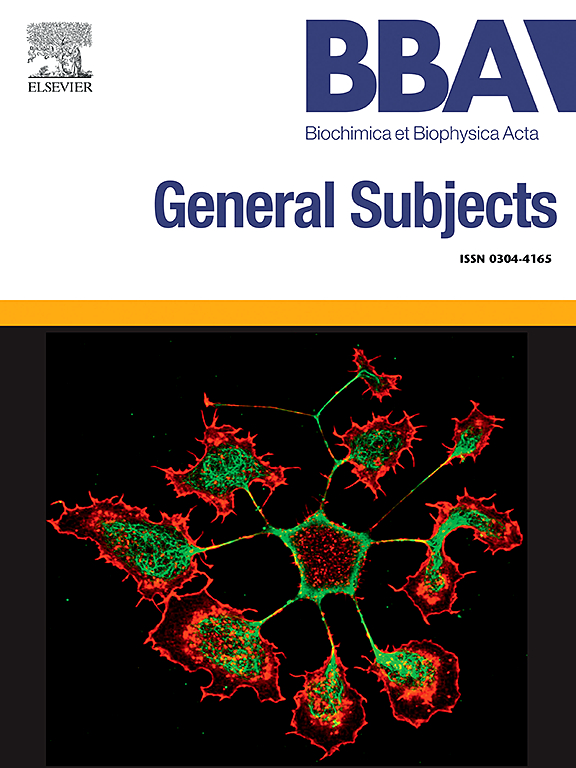Ferroptosis induction, androgen biosynthesis disruption and prostate cancer suppression by androgen and vitamin D combination
IF 2.2
3区 生物学
Q3 BIOCHEMISTRY & MOLECULAR BIOLOGY
Biochimica et biophysica acta. General subjects
Pub Date : 2025-05-28
DOI:10.1016/j.bbagen.2025.130828
引用次数: 0
Abstract
Prostate cancer regression by hormonal vitamin D3(calcitriol) is clinically untenable despite its well-documented anticancer effects in experimental models, since supraphysiologic dosing of calcitriol required in clinical settings causes hypercalcemia and other toxicities. We show that subnanomolar/low-nanomolar calcitriol, while non-inhibitory on its own, inhibited CRPC cells upon co-treatment with androgen (5α-DHT) at a physiologic level, evident from G1/S cell cycle arrest, induction of p21/Cip1, blockade of clonal cell growth, retardation of proliferation, migration and invasion of cells in vitro, and xenograft growth suppression in vivo. AKR1D1, an androgen-inactivating 5β-reductase, was upregulated >30-fold upon calcitriol/DHT co-treatment, while each hormone individually did not induce AKR1D1. In contrast, HSD3β1, a key enzyme for androgen biosynthesis, was upregulated >12-fold by calcitriol, which was blocked by DHT co-treatment. Elevated AKR1D1 and reduced HSD3β1 would lower intracellular androgens and contribute to CRPC repression. Autophagy mediated ferroptosis (ferritinophagy) paralleled CRPC growth inhibition by the hormone combination –indicated by LC3B induction, ferritin reduction, and upregulation of mRNAs encoding NCOA4, ALOX-5 and PTGS2 which are core participants in ferroptosis. The combination treatment caused lipid peroxidation, evident from the fluorescence shift of C11-BODIPY(581/591)-labeled cells from red to green, and from elevated malondialdehyde. GPX4 - an antioxidant peroxidase and ferroptosis regulator – was downregulated. Bipolar androgen therapy employing supraphysiologic testosterone is under clinical evaluation for efficacy against treatment-resistant metastatic CRPC, although the high androgen dose raises safety concerns. Vitamin D and androgen administered concurrently at physiologic levels may offer a superior alternative for arresting CRPC.
雄激素和维生素D联合诱导铁下垂、雄激素生物合成中断和前列腺癌抑制。
激素维生素D3(骨化三醇)的前列腺癌消退在临床上是站不起来的,尽管它在实验模型中具有良好的抗癌作用,因为临床需要的骨化三醇的高生理剂量会导致高钙血症和其他毒性。我们发现,亚纳摩尔/低纳摩尔骨化三醇虽然本身没有抑制作用,但在与雄激素(5α-DHT)共同作用时,在生理水平上抑制CRPC细胞,表现为G1/S细胞周期阻滞、诱导p21/Cip1、阻断克隆细胞生长、体外细胞增殖迟缓、迁移和侵袭,以及体内异种移植物生长抑制。AKR1D1是一种雄激素失活的5β-还原酶,骨化三醇/二氢睾酮共处理后,AKR1D1的表达上调了30倍,而每种激素都没有单独诱导AKR1D1。相比之下,雄激素生物合成的关键酶HSD3β1在骨化三醇的作用下上调了10倍,而DHT共处理可阻断HSD3β1的表达。升高的AKR1D1和降低的hsd3 β1会降低细胞内雄激素,并有助于抑制CRPC。自噬介导的铁细胞凋亡(铁蛋白噬)与CRPC生长抑制平行,通过激素组合-通过LC3B诱导,铁蛋白还原和编码ncoa4, ALOX-5和ptgs2的mrna上调,这些mrna是铁细胞凋亡的主要参与者。联合处理引起脂质过氧化,从C11-BODIPY(581/591)标记细胞的荧光从红色变为绿色以及丙二醛升高可以看出。GPX4 -一种抗氧化过氧化物酶和铁下垂调节因子-被下调。尽管高雄激素剂量引起了安全性问题,但采用生理上睾酮的双极雄激素治疗对治疗抵抗性转移性CRPC的疗效仍未得到临床评估。在生理水平上同时给予维生素D和雄激素可能为阻止CRPC提供更好的选择。
本文章由计算机程序翻译,如有差异,请以英文原文为准。
求助全文
约1分钟内获得全文
求助全文
来源期刊

Biochimica et biophysica acta. General subjects
生物-生化与分子生物学
CiteScore
6.40
自引率
0.00%
发文量
139
审稿时长
30 days
期刊介绍:
BBA General Subjects accepts for submission either original, hypothesis-driven studies or reviews covering subjects in biochemistry and biophysics that are considered to have general interest for a wide audience. Manuscripts with interdisciplinary approaches are especially encouraged.
 求助内容:
求助内容: 应助结果提醒方式:
应助结果提醒方式:


